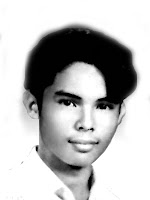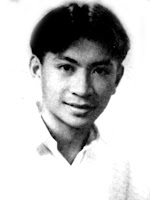My All-Time LSFC Dream Team
On more than just a few occasions, I had wondered what it would have been like to have had all these players all at the same time, instead of distributed over three decades. What team would I have selected?
Well, this is really an exercise in futility because it is the sort of thing that only happens in the movies. Still, just for the sheer heck of it, why not? Here is how that team will probably look like. Please note that the line-up only comes from those who played in my high school teams.
GOALKEEPER
Starting: Francis Roy Simeon (HS 1998). This is a tricky one. Although my training and tactics are sound on the outfield, I had always been the first to admit that goalkeeping was my Achilles heel. That said, for some strange reason, I have had some really outstanding goalkeepers over the years. Simeon gets the starting position not only for his safe hands but his height, reach and the amount of space he covered of that thing we call the goal.
Backup: Ramil Maravilla (HS 1985): Not really tall for a goalkeeper; but probably the most gymnastic of all the goaltenders who played under me in three decades of football. He once saved a volley from point blank range in a friendly against Colegio San Agustin, catching the ball while still horizontal in the air. Lesser ‘keepers would have punched or pushed the ball away; but Maravilla caught the ball with both hands. This stands out in my mind to this day as the best-ever save by any of my goalkeepers over three decades of LSFC football.
[Note: The late Darwin Motel (HS 1994) was the only LSFC goalkeeper to have ever worn the national colours; but in high school he was still a work in progress. All credit to the coaching staff at San Beda College for bringing out the best in him.]
RIGHTBACK
Starting: Johnny Garcia (HS 1988). Tall and powerfully built, Garcia was extremely difficult to pass for any opposing left-winger. Although his ball control was excellent for a fullback, he also liked to keep things simple and play short to either the midfielders or back to the goalkeeper. When necessary, he could belt the ball upfield with his powerful right foot.
Backup: Carlito Reyes (HS 1998). There were probably more skilful right-backs over the years; but I have gone for Reyes because, like Garcia, he had the right physique for the modern game. Although a tad smaller than Garcia, Reyes was, in fact, more muscular and not at all averse to making wingers know it would hurt to try to get past him.
[Note: I thought long and hard about Erik Nelson Carbonilla (HS 1989), perhaps the fiercest-tackling fullback of all. The temperament, though, was a bit suspect; and lack of height also weighed against him.]
CENTRAL DEFENDERS
Starting: Jonathan Casas (HS 1989). The one-armed general came to the fore during the 1988 Coca-Cola Go-for-Goal, when he struck an outstanding partnership with batch-mate Jerry Acosta at the heart of defence. Casas was outstanding in the way he dominated his entire back-line, continually barking out instructions to ensure that the defence moved as a unit. Blessed with a sharp athlete’s brain, he was comfortable whether we were dominating opponents with the back-line high; or we were playing stronger teams that forced us to sit in front of the penalty box.
Backup: Ted Villanueva (HS 2011). Captain of his team, Villanueva was one of the few players over the decades who I could say actually enjoyed defending. He was the sort who would chase even lost causes. Like Casas, he was also always barking out instructions to other defenders. Villanueva, though, was better at heading the ball either defensively or when he went up for corner kicks.
Starting: Jerry Acosta (HS 1989). Acosta was six-foot flat when he was a senior in high school; which meant that anything hoofed from the opponents’ backline was bound to be powerfully headed back to whoever punted it. So dominating was his presence that, when you think about it a certain way, he actually made Casas’ job behind him so much easier. Acosta’s major weakness was his lack of pace; but he had such long legs that it was hard for opponents to pass him, anyway.
Backup: Nestor Natanauan (HS 2011). Still growing and only 15 when he graduated from high school, Natanauan was, even then, already my height. Just as the Casas-Acosta tandem had a great chemistry to it, the Villanueva-Natanauan understanding was also almost clairvoyant. Natanauan did not have Acosta’s height but possessed unusually long legs and an outstanding defender’s brain as well. Like his partner Villanueva, he could also score goals off corner kicks.
LEFTBACK
Starting: Leo Gherardelli (HS 2000). This is another tricky one, because my preference is a left-sided full-back; and Gherardelli was right-sided. Despite the handicap, however, he was easily the best left-back to ever wear the LSFC colours. Tall and leggy – if with a suspect temperament – he hated losing and probably played harder when things were not going our way. He was also probably the most outstanding overlapping full-back who ever played for me.
Backup: Henry Roque (HS 2001). Probably the best naturally left-sided fullback in all three decades of LSFC; although, that said, there were not really a lot of them. Roque gets the nod because no coach in his right mind would play a right-sided player at left-back when there is a good left-sided one available. Having played right-wing in my high school and college days, I know from experience how substantially more difficult it is to pass a left-sided left-back because he turns quicker to his left.
[Note: Gherardelli, despite being right-sided, gets the starting position because he was also a substantially stronger defender even if Roque was left-sided.]
RIGHT WINGHALF
Starting: Jose Carlos Lucido (HS 1984). By no means blessed with close ball control, Lucido gets the starting position because of his immense engine and his ability to cover every blade of grass along the right flank. Probably not the best crosser of the ball, but his value was in how he could be helping the right-back defend one moment then be scampering forward to support the attack in the next. Also an outstanding leader, Lucido was captain of his team.
Backup: Ezekiel Terrones (HS 2011). Easily the best crosser of the ball from the right wing in all three decades of LSFC football. It was from his crosses that Joseph Victor Medina and Lorenzo Gherardelli got a bucketful of goals. Could have been the first-choice wing-half but for his lack of size and the occasional ability to get cramped before a match was concluded.
HOLDING MIDFIELDER
Starting: Emerson Dagpa (HS 1989). Dagpa was a holding midfielder long before it became fashionable to use the term. His strength was in his simplicity. Although not big, he protected the back-line by snuffing out attacks with fierce tackles while still in midfield. When retrieving possession of the ball, he kept things simple and never held on to the ball for too long.
Backup: Jonas Lumawag (HS 1985). This player was elegance personified, never in a hurry and always as though just strolling along. Equally good at protecting the back-line as Dagpa. The outstanding thing about Lumawag was his range of passing with either foot, so that a counter-attack could always be quickly launched with a measured pass from either of his cultured feet. He also packed a powerful right-footed shot.
CREATIVE MIDFIELDER
Starting: Eduardo Marasigan Jr. (HS 1988). Probably the most gifted player over three decades of LSFC football. I knew the moment I laid eyes on him – and he was a snotty elementary student – that he would one day become a national player. Marasigan’s greatness was not only in his excellent ball control but also in how he wove passes together with team-mates to create one glowing move after the other. He was the master of the short passing game and revelled in playing short one-twos with team-mates.
Backup: Joel Carbonilla (HS 1990). Another small player who excelled at the traditional LSFC game of playing along the carpet. Carbonilla, who learned his football in Liberia, was the natural successor to Marasigan; and in fact, when the latter graduated in 1988, the former seamlessly took over the midfield general’s role. There is little to choose from between the two, as a matter of fact; and one can substitute for the other with hardly any impact on the team.
[I thought long and hard about Mark Allen Padua (HS 1999) who probably had a better range of passing than Carbonilla. In the end, I went for Carbonilla because of the physicality of his game compared to Padua, who was somewhat lightweight in high school. That said, Padua was not that far away in terms of skills, just to illustrate the depth of quality over the years.]
LEFT WINGHALF
Starting: Jeremias Jiao (HS 2001). Another LSFC player who would go on and play for the national team. Jiao was a naturally left-sided wing-half with a cultured left foot and excellent crossing ability. He also had a great engine and could help the left-back when necessary. Although mostly prowling down the left flank, it was not unusual for him to cut inside and score goals. He, perhaps, had a weakness in that his right foot was next to useless; but the left was so cultured that it really did not matter.
Backup: Carlo Magno Olmos (HS 1988). Although Olmos was right-sided, there was no way to tell just by watching him; such was his excellent crossing ability. In fact, if I switched him over to the right, he probably would not have played as well. The only reason Jiao is preferred for the starting position is because of his left-sidedness. In fact, Olmos can start a game over Jiao with no loss of ability insofar as team play is concerned.
STRIKERS:
Starting: Erwin Sibayan (HS 1990). Outstanding when playing with his back to the goal to set up his strike partner or midfielders making runs forward; but he was also an elegant player who could lead the line on his own and was a regular goalscorer. Not the archetypal muscular target man. Instead, Sibayan was effective in that he had a lightning-quick footballing brain plus close ball control and precise short passing.
Backup: James Dimaculangan (HS 2001). Over six feet tall, Dimaculangan was probably the most potent aerial threat over three decades of LSFC football. Having come from the volleyball teams, he had this ability to hang in the air when he jumped to time his headers, with which he scored countless goals. His control when the ball was on the floor, perhaps, sometimes left a lot to be desired; but there were few players I would rather have waiting for a cross from either flank.
Starting: Eldrich de Villa (HS 1999). Having scored the LSFC high school record of 56 goals in one season, this was an easy decision to make. De Villa was quick off the mark and could shoot with either foot. Despite being only of medium height, he was also capable of scoring the occasional headed goal.
Backup: Reyan Quinto (HS 1996). This is another tricky one because, in his team, Quinto led the line and played more in the Sibayan or Dimaculangan mould. Having said that, he was a proven striker with a goalscoring record that was bested only by de Villa’s. It will be foolhardy to leave him out of the team. Like de Villa, Quinto was two-footed and deadly when in the penalty area.
-------------------------------------------------------------------------------------------
If you enjoyed this article, please click the Like button or share it freely on social media. It helps to pay this site's domain name and maintenance costs.




























Post a Comment